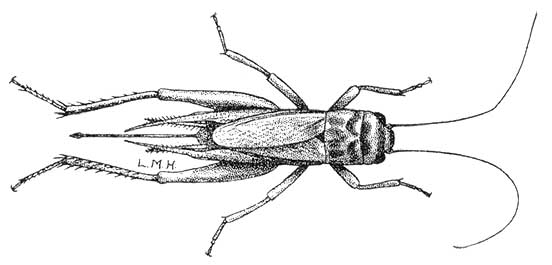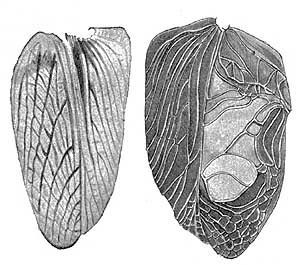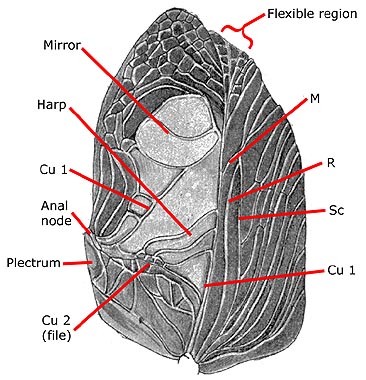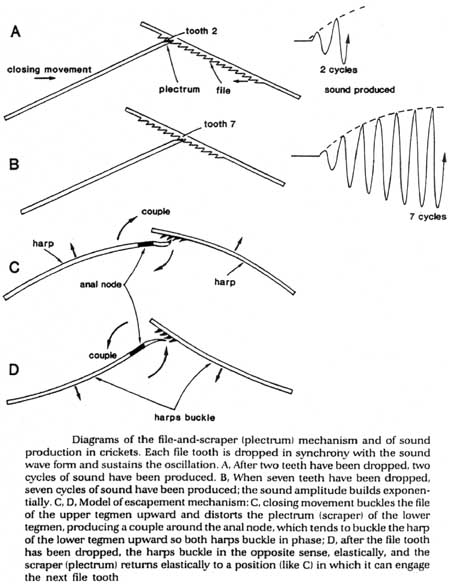

body length 15mm, ovipositor 12 mm
Gryllus field crickets
BUG OF THE MONTH: March 1998
House Crickets
Acheta domesticus
Order Orthoptera, Family Gryllidae
Copyright © 1998 by Louise Kulzer
This article originally appeared in Scarabogram, March 1998, New Series No. 215, pp. 2-4.
House crickets are often associated with the new year and good luck. Although some (including the Audubon field guide) say that crickets are a nuisance because of their continuous chirping, others value them for that very characteristic. Indeed, unlike most other insects, cricket songs are characterized by almost pure tones of constant frequency (Simmons & Ritchie 1996).
 |
 |
| Acheta domesticus, adult female, body length 15mm, ovipositor 12 mm |
Female (left) and male wings of Gryllus field crickets |
In China and Japan, crickets have been brought indoors to delight inhabitants for almost 1000 years! Valued for their song, crickets were kept in small cages of bamboo or other materials. Crickets were also valued for sport, with cricket fighting coming into vogue during the Sung Dynasty (960-1279 A.D.). Books detailing the collection, care and feeding of crickets were written, as well as techniques for conducting a proper cricket fight. Special diets of rice mixed with delicacies such as cucumbers, lotus seeds or mosquitoes were fed to the little warriors (Walker & Masaki 1989). Incidentally, Hack (1977) found fighting to be highly demading in terms of energy costs for crickets, and also found that acoustic signalling was the most efficient of the seven measured antagonistic response tactics measured. So listen up! Maybe there is a good reason for nagging, huh? Why don't you ever listen to me and clean out the cricket cage, huh?
 |
| Sound apparatus on male wing of Gryllus field cricket (separated from rest of wing by flexible cuticle). Harp and mirror are resonators. |
House crickets have not been caged in all cultures. Many folk tales feature crickets living free in a favored spot in the house - often near the hearth, wood stove or oven. With the help of Vickie Galloway's article in the January issue, almost anyone can keep crickets, if they wish. Whether to cage or not is a decision each household will have to make for themselves. And while you're contemplating this important question, here are some aspects of cricket biology you'll find of interest.
Generally, only male crickets stridulate or sing. Additionally, the relative amount of sound production varies within a population, some males being better songsters than others. And in a few species, the ability to produce sound has been lost altogether. A cricket song is distinct for each species, and indeed, the discriminating field biologist can tell how many species of crickets there are in an area simply by listening, somewhat like a good birder!

Cricket songs are produced with the forewings, or tegmina. The vein Cu2 of the tegmina is sclerotized in a series of sharp teeth to form a file. Further, a sharp-edged sclerotized ridge on the outer edge of the wing forms a plectrum, or scraper. By moving the scraper across the other wing's file, a vibration is set up which resonates on an area of the wing known as the harp. See wing diagram (above) and figure at right from Bennet-Clark (1989) and use your imagination! As far as I can tell, there is both a file and a plectrum on each wing. This would mean that a cricket could produce either a left-winged or a right-winged song. Now I could think of a few great research projects, especially for audiophiles. Perhaps there is a difference in the sound produced by left-winged versus right-winged stridulations? Wow, and you thought people raised crickets just for fun.
Cricket song has two components, one influenced by the plectrum-file strike rate and the other related to the subalar air space between the wing and the abdomen. Some have suggested that cricket song is a dynamic process involving auditory feedback control (Stephen & Hartley, 1995). Can't you just see cricket choir practice? By Jimminy, just listen to yourselves! Your strike rates aren't at all synchronized, and you're all on different keys.
Moving along, some other things that might be of interest to those who invite
crickets into their homes:
• Call frequency is a reliable indicator of male size (Simmons & Ritchie
1996). That means a female cricket can tell how big a male is just by listening
to the pitch of the song. Handy.
• Male crickets produce spermatophores to transfer sperm to the female.
Neat.
• Most crickets mate with the female above (did Sung dynasty women know
this? Maybe that's why they were so popular, for inspiration? read Haiku for
clues.)
• The forewings of male crickets are shorter than those of females and
the stridulatory areas are expanded to accommodate their sound-producing role.
This in addition to the file and plectrum modifications is another example of
"form follows function."
• Male crickets have had their wings modified for producing sound since
the Permian. Now that's evolutionary conservatism, huh?
• There is a Tachinid fly, one Euphasiopteryx depleta, that can
home in on the call of some mole crickets. The
fly larviposits nearby, and the larva attaches to the cricket, burrows in and
lives as an endoparasite. The cricket is reported to die within 6 to 8 days
(Fowler, 1987). Hey, it might happen to house crickets too some day! Put a screen
on that cage, would ya?
• Other predators that are known to hunt crickets by their sound include
cats, herons and geckos. However, as most humans know, crickets will stop vocalizing
when approached. They learned that shortly after the Permian!
There's much more to know and find out about crickets. How does temperature affect chirp frequency? Do the offspring of good singers themselves sing better? What do house crickets do when a field cricket is introduced within auditory range? Do kids play better with vocalizing crickets around? Do males sing better when fed certain diets? Only your imagination limits the fun you can have and the amount you can learn from these long-established insect companions. Report your observations in Scarabogram!
Have fun and prosper.
References
Bennett-Clark, H.C. 1989. Songs and the physics of sound production. In: Cricket Behavior and Neurobiology. (ed. F. Hubrer, T.E. Moore and W. Loher), pp. 227-261. Ithaca, New York: Cornell University Press.
Fowler, H.G. 1987. Field behavior of Euphasiopteryx depleta (Diptera: Tachinidae): phonotactically orienting parasitoids of mole crickets. Journal of the New York Entomological Society, 95: 474-480.
Hack, M.A. 1997. The energetic costs of fighting in the house cricket Acheta domesticus L. Behavioral Ecology, 8(1): 28-36.
Simmons, L.W. & M.G. Ritchie. 1996. Symmetry in the songs of crickets. Proceedings of the Royal Society of London, B26: 1305-1311.
Stephen, R.O. & J.C.Hartley. 1995. Sound production in crickets. Journal of Experimental Biology, 198: 2139-2152.
Walker & Masaki. 1989. Cricket Natural History. In: Cricket Behavior and Neurobiology. (ed. F. Hubrer, T.E. Moore and W. Loher). Ithaca, New York: Cornell University Press.
This page last updated 16 June, 2005